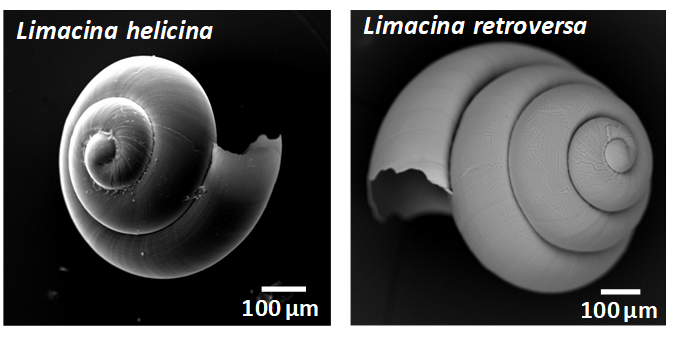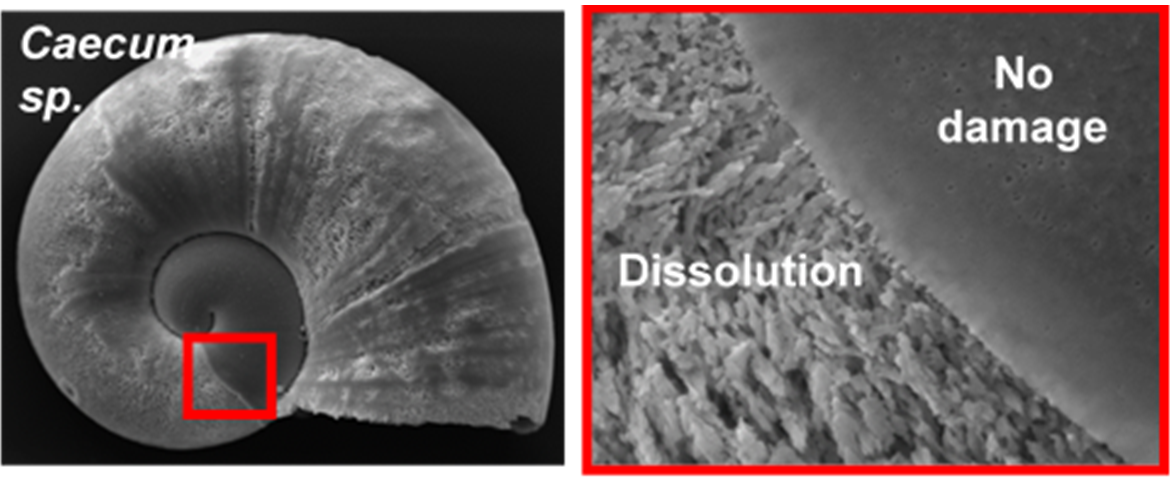Pelagic gastropods (sea snails) are molluscs. This group comprises gastropods which spend their entire life cycle as planktonic organisms (mainly pteropods) as well as the pelagic larvae of otherwise benthic gastropod species. These organisms play an important part in the pelagic food web and in biogeochemical cycles of the ocean.
Pelagic gastropod specimens collected monthly between 2011 and 2013 from the Scottish Coastal Observatory (SCObs) monitoring site at Stonehaven were examined using scanning electron microscopy (SEM) and the relationship with ocean acidification (pH and aragonite saturation, Ωarg) investigated (León et al., 2019). Two species of pteropods (Limacina retroversa and Limacina helicina) (Figure 1) and the larvae of several benthic gastropod species were identified from collected samples.

Figure 1: Scanning Electron Microscopy images of the pelagic gastropods Limacina helicina and Limacina retroversa.
The SCObs site at Stonehaven remained supersaturated with respect to aragonite and calcite (Ωarg >1) throughout the duration of the study, implying that aragonite concentration is not a limiting factor for the formation of the shells of these gastropods. However, the majority of taxa were found to have evidence of shell dissolution (Figure 2), with the highest proportion of dissolution occurring as the Ωarg decreased towards the winter months. Other field studies, such Peck et al. (2018) in the Greenland Sea also reported shell dissolution under supersaturated conditions.

Figure 2: Evidence of shell dissolution in pelagic gastropod larvae specimen.
The proportion of shell dissolution was highest in the early life stages (larvae) of gastropods. The amount of shell dissolution was not consistent across taxonomic groups implying that the response of marine calcifiers to ocean acidification may differ.
The temporal variability of shell dissolution and carbonate chemistry highlights the requirement for a longer time series of data to further the understanding of the response of calcifying plankton to ocean acidification.
Marine ecosystems are adapted to their physical and chemical environment. Any changes in the physical characteristics of the marine environment can influence marine life and sustainable use of the seas. It is therefore important to understand changes in these physical and chemical characteristics in assessing whether we are working towards Scotland’s vision for clean, healthy, safe, productive, biologically diverse marine coastal environments, managed to meet the long-term needs of nature and people.
This assessment of physical and chemical characteristics covers, circulation, sea level, waves, temperature and salinity, as well as stratification and water clarity (turbidity).
The oceans are absorbing much of the carbon dioxide and excess heat resulting from a changing global climate. This absorption results in ocean acidification and increasing temperatures contribute to a loss of oxygen from the sea. These processes may have an adverse impact on marine life, and therefore the latest information on ocean acidification and dissolved oxygen (one of the Clean and safe Eutrophication assessments) are also presented.
The five case studies demonstrate some applications related to these assessments. These include a review of Scotland’s tidal stream resource, an example of dissolved oxygen measurements using novel technologies, and three illustrations of variability of ocean acidification and marine organisms (two species of calcifying plankton, coccolithophores and pelagic gastropods at Stonehaven, and one species of cold-water coral).
The Physical characteristics and ocean acidification assessment in Scotland’s Marine Atlas 2011 can be found on the Scottish Government web archive here.

Links and resources
|
, 2019. Relationship between shell integrity of pelagic gastropods and carbonate chemistry parameters at a Scottish Coastal Observatory monitoring site. ICES Journal of Marine Science. Available at: https://academic.oup.com/icesjms/advance-article/doi/10.1093/icesjms/fsz178/5584407. |

